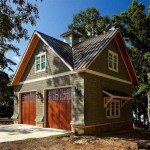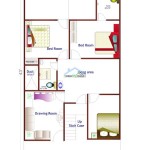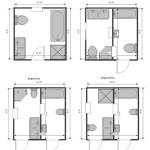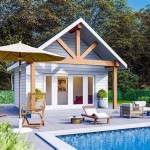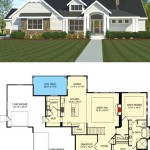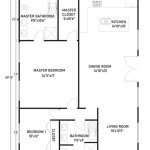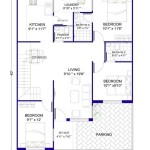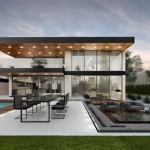Contemporary House Plans: A Synthesis of Style and Functionality
Contemporary house plans represent a dynamic and evolving architectural approach that prioritizes clean lines, open spaces, and a seamless integration with the surrounding environment. Unlike modern architecture, which adheres to a specific historical period, contemporary design embraces current trends and incorporates innovative materials and technologies. This flexibility allows for a diverse range of interpretations, resulting in homes that are both aesthetically pleasing and highly functional for modern living.
The defining characteristics of contemporary house plans extend beyond mere aesthetics. These plans often emphasize energy efficiency, sustainable building practices, and adaptability to changing lifestyle needs. A contemporary home should not only look good but also perform optimally, providing a comfortable and sustainable living environment.
Understanding the key elements of contemporary house plans is crucial for anyone considering building or renovating a home. This article will explore several key aspects of this architectural style, offering insights into the design principles, material choices, and spatial configurations that define contemporary living.
Open-Concept Living and Spatial Fluidity
One of the most recognizable features of contemporary house plans is the emphasis on open-concept living spaces. This design approach eliminates or minimizes walls between key areas, such as the living room, dining room, and kitchen, creating a fluid and interconnected environment. The result is a greater sense of spaciousness, natural light penetration, and enhanced social interaction.
Open-concept layouts are particularly well-suited for modern families who value shared experiences and a relaxed atmosphere. The absence of physical barriers allows for seamless communication and movement between different activity zones. This design also facilitates entertaining guests, as the host can easily interact with visitors while preparing food or tending to other tasks.
However, open-concept living requires careful planning to avoid a sense of disorganization or lack of definition. Strategic use of furniture placement, area rugs, and changes in flooring materials can help delineate different zones within the larger space. Furthermore, incorporating architectural features such as partial walls, columns, or changes in ceiling height can add visual interest and create a sense of separation without sacrificing the overall openness.
The fluidity of space in contemporary homes extends beyond the main living areas. Hallways are often minimized or eliminated entirely, replaced by strategically placed pathways that connect different rooms. This approach contributes to a more efficient use of space and minimizes the feeling of being confined or restricted.
Large windows and sliding glass doors are integral to the open-concept design. These elements blur the lines between indoor and outdoor spaces, allowing natural light to flood the interior and providing unobstructed views of the surrounding landscape. The connection to nature is a key aspect of contemporary design, promoting a sense of well-being and enhancing the overall living experience.
The integration of technology is also a consideration in open-concept designs. Smart home systems can be seamlessly integrated throughout the space, providing convenient control over lighting, temperature, and entertainment systems. This integration enhances the functionality and usability of the open-concept layout, making it even more appealing for modern lifestyles.
Ultimately, the success of an open-concept design lies in its ability to balance spaciousness and connectivity with a sense of privacy and functionality. Careful planning and attention to detail are essential to create a living environment that is both aesthetically pleasing and highly practical for everyday living.

Emphasis on Clean Lines and Minimalist Aesthetics
Contemporary house plans are characterized by a strong emphasis on clean lines and minimalist aesthetics. This design philosophy prioritizes simplicity, functionality, and a refined sense of elegance. Ornamentation is typically kept to a minimum, with the focus instead on showcasing the beauty of the building materials and the clarity of the architectural form.
Clean lines are evident in every aspect of the design, from the exterior facade to the interior finishes. Simple geometric shapes, such as rectangles and squares, are commonly used to create a sense of order and visual harmony. The use of horizontal lines is particularly prevalent, creating a sense of groundedness and stability.
The minimalist aesthetic extends to the selection of materials and finishes. Contemporary house plans often feature a limited palette of colors and textures, typically focusing on neutral tones such as white, gray, and beige. Natural materials such as wood, stone, and concrete are frequently used to add warmth and visual interest without compromising the overall simplicity of the design.
The absence of clutter is a key aspect of the minimalist aesthetic. Contemporary homes are designed to be uncluttered and organized, with ample storage space to keep belongings out of sight. Built-in cabinetry, hidden storage compartments, and minimalist furniture designs contribute to a sense of order and tranquility.
Lighting plays a crucial role in enhancing the minimalist aesthetic. Recessed lighting, track lighting, and minimalist pendant fixtures are commonly used to provide ample illumination without detracting from the overall simplicity of the design. Natural light is also maximized through the use of large windows and skylights, further enhancing the sense of spaciousness and airiness.
The minimalist aesthetic is not merely about eliminating unnecessary ornamentation; it is about creating a sense of calm and serenity through simplicity and intentional design. By stripping away extraneous details, the focus is placed on the essential elements of the home: the architecture, the materials, and the flow of space.
This emphasis on clean lines and minimalist aesthetics creates a timeless and elegant look that is both visually appealing and highly functional. Contemporary homes designed with this philosophy are often perceived as being modern and sophisticated, yet also warm and inviting.

Sustainable Design and Energy Efficiency
Contemporary house plans increasingly prioritize sustainable design and energy efficiency. This reflects a growing awareness of environmental concerns and a desire to create homes that are both comfortable and environmentally responsible. Sustainable design principles are integrated into every aspect of the construction process, from the selection of materials to the implementation of energy-efficient technologies.
One of the key aspects of sustainable design is the use of environmentally friendly building materials. Recycled content materials, such as recycled steel and reclaimed wood, are often used to reduce the environmental impact of construction. Renewable materials, such as bamboo and cork, are also gaining popularity for their sustainable properties.
Energy efficiency is a major focus in contemporary house plans. High-performance windows and insulation are used to minimize heat loss and gain, reducing the need for excessive heating and cooling. Solar panels can be integrated into the roof design to generate renewable energy, further reducing reliance on fossil fuels. Geothermal heating and cooling systems are also becoming increasingly common, providing a highly efficient and sustainable alternative to traditional HVAC systems.
Water conservation is another important consideration in sustainable design. Low-flow faucets and showerheads are used to reduce water consumption, while rainwater harvesting systems can be installed to collect rainwater for irrigation and other non-potable uses. Drought-tolerant landscaping is also essential for minimizing water usage in the landscape.
Passive solar design is a key strategy for maximizing energy efficiency. This involves orienting the house to take advantage of the sun's natural heating and cooling properties. Large windows on the south-facing side of the house allow sunlight to warm the interior during the winter months, while overhangs and shading devices can prevent overheating during the summer months.
Smart home technology plays a crucial role in optimizing energy efficiency. Smart thermostats can automatically adjust the temperature based on occupancy and weather conditions, while smart lighting systems can dim or turn off lights when they are not needed. These technologies can significantly reduce energy consumption and lower utility bills.
Sustainable design is not only good for the environment; it also improves the comfort and health of the occupants. Natural materials, ample natural light, and good ventilation create a healthier indoor environment, reducing the risk of allergies and respiratory problems. Furthermore, energy-efficient homes are often quieter and more comfortable, providing a more relaxing and enjoyable living environment.
Integrating sustainable design principles into contemporary house plans is a win-win situation. It reduces the environmental impact of construction and operation, lowers utility bills, and improves the comfort and health of the occupants. As environmental awareness continues to grow, sustainable design will undoubtedly become an increasingly important aspect of contemporary architecture.

Contemporary house plans represent a fusion of aesthetics, functionality, and sustainability. The emphasis on open-concept living, clean lines, and energy efficiency reflects the evolving needs and priorities of modern homeowners. By embracing these key principles, contemporary architecture offers a dynamic and adaptable approach to creating homes that are both beautiful and environmentally responsible.

Modern 2 Bedroom House Plan 61custom Contemporary Plans Courtyard Floor

Contemporary House Plans Modern Home The Designers

Beautiful 2 Story Contemporary Style House Plan 1747 The Journey

Contemporary Modern House Plan 3 Bedroom 2 5 Bath Pool

Modern Open Floor House Plans Blog Eplans Com

4 Bedroom Modern Contemporary House Plan Plans

Contemporary House Plans Home Design Floor

House Design Contemporary Home Ch183 31 Modern Plans Small

Plan 44207 Modern Prairie House With 2499 Sq Ft 4 Bedroom

Modern House Plans Sater Design Collection

